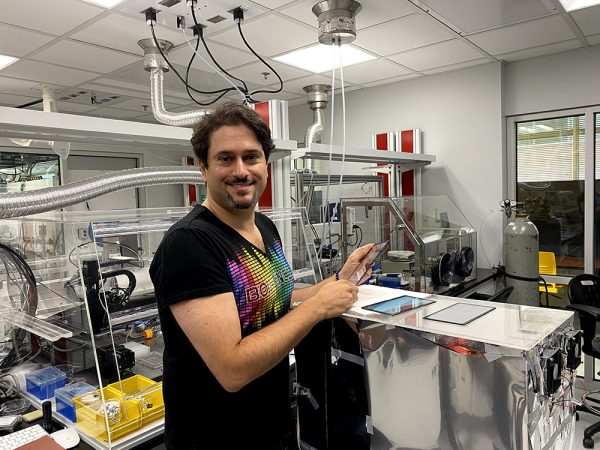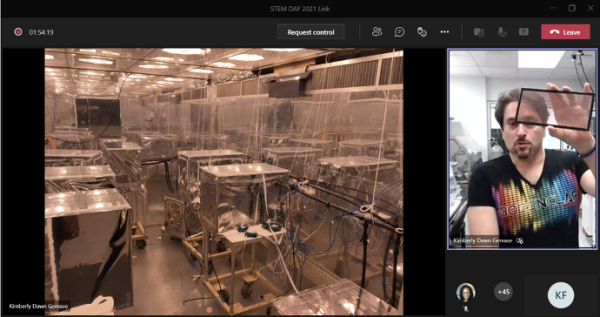Article by Niki Jennings, NC State MSE Communications Specialist

On July 23, 2021, the North Carolina Science Olympiad and sponsor Wolfspeed—formerly Cree | Wolfspeed — virtually hosted their 4th annual Family STEM Day to a worldwide audience of employees and their children. Dr. Aram Amassian gave an engaging and interactive keynote presentation that included robots to explore new technologies in carbon-based electronics and energy. Prior to the event, representatives from Wolfspeed filmed tutorials and shipped grade-level appropriate activities to every registered student. Activities included solar art, fans built from batteries or solar cells, and a solar car. The Wolfspeed Family STEM day represented eight countries outside of the United States including Germany, Switzerland, France, and Taiwan. The presentation has been translated into multiple languages.
Wolfspeed’s founders began their pioneering work with silicon carbide semiconductors at an NC State lab. In fact, the origins of the company name harken back to the founder’s start as part of the NC State Wolfpack – while also incorporating speed, part of the company’s brand promise. Strong proponents of STEM education, the global semiconductor powerhouse appeals itself to the next generation by hosting an annual Family STEM day. Wolfspeed is leading the transformation from silicon to silicon carbide – enabling technologies such as electric vehicles, renewable energy, 5G, industrial applications, and more. Its commitment to education, and belief in the power of STEM education to change lives is why events like STEM Day are important for the company.
For the keynote presentation, Dr. Amassian, a professor in the Department of Materials Science and Engineering, partnered with Kim Gervase of The Science House in the College of Sciences. Dr. Amassian’s talk focused on sustainable technologies. He explained solar energy, where light can be harvested naturally using plants, as well as artificially using solar cells. He discussed the future of food production using solar-powered greenhouses, where new organic solar cell materials make it possible to grow food in greenhouses sustainably while sharing different parts of sunlight for photosynthesis (plants) and photovoltaics (power generation) without affecting crop production yield. In locations that are not sustainable for plant growth, plants can use red and green colors on the light spectrum while the rest of the sunlight is used for climate control of the greenhouses. Additionally, he touched on how plants and leaves can teach us how to make solar cells more resilient and long-lasting, as well as materials for PPE that can kill pathogens like SARS-COV-2 (which causes COVID-19) on contact. Dr. Amassian has been creating carbon-based electronic, photonic, and energy materials that can be directly used for many applications, including to combat climate change.

Presentations also included the future of work, manufacturing, and innovation. Dr. Amassian illustrated how robots he is building and deploying in his lab help others tackle and solve increasingly complex problems in materials. This also helps student scientists and engineers become more productive and efficient working in the lab in the same way calculators and computers helped us compute and solve math problems faster than ever before.
Outreach is another deep-seated focus for Dr. Aram Amassian. A recent project includes a Catalyst program for kids with disabilities. As a newly NSF-funded project for the next few years, Dr. Amassian has found many kids on the Autism spectrum who don’t excel in the traditional school setting are incredible problem solvers. By introducing kids to carbon-based electronics combined with plants, medicine, AI, and robots, he aims to boost the interest of kids in the field and continue to build the STEM pipeline. For instance, Dr. Amassian has students in his lab with hand disabilities who use robots to offset tasks and complement productivity. Dr. Amassian says he’s excited to see how well these tools have been received by other researchers and educators and expects them to one day become a normal part of our STEM education, training, and research infrastructure.
The future looks bright for Dr. Aram Amassian. By focusing on future solutions to current problems, and engaging the next generation, Dr. Amassian is setting up a foundation for exciting future job opportunities.
For more information on Wolfspeed, visit wolfspeed.com.